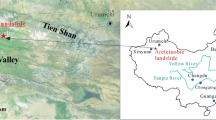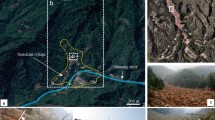Abstract
During a landslide, the multi-phase nature of landslide debris defines its mobility. Eventually, frictional forces cause the slide energy to dissipate, and contact forces transmit the energy into nearby material. Using comparative analysis which analyzes the mobility characteristics of flow-like landslides with various slide materials, we conducted flume model experiment. Our conclusions are as follows: (1) liquid-phase flow-like landslides are highly mobile and have long runout; solid-phase flow-like landslides are highly destructive because of their higher kinetic energy; and two-phase flow-like landslides are both highly mobile. (2) During a two-phase flow-like landslide, the mobility ability of the liquid-phase material is stronger than that of the solid-phase material; when the liquid slide volume fraction is sufficiently large, the liquid phase exerts a drag force on the solid phase. (3) Various liquids exert different drag effects on the solid; the solid–liquid velocity difference and the liquid viscosity determine the drag intensity and the mobility and depositional characteristics of the landslides. The results provide experimental support for the further study of the influence of multi-phase properties of flow-like landslides on the mobility characteristics of landslides.









Similar content being viewed by others
References
Ahmadipur A, Qiu T, Sheikh B (2019) Investigation of basal friction effects on impact force from a granular sliding mass to a rigid obstruction. Landslides
Anderson TB, Parnell J, Ruffell AH (1995) Influence of basement on the geometry of Permo-Triassic basins in the northwest British Isles. Geol Soc Lond Spec Publ 91(1):103–122
Av A, Omb C, Pf A et al (2019) Seismic and geological controls on earthquake-induced landslide size. Earth Planet Sci Lett 506:268–281
Bedford A, Drumheller DS (1983) Theories of immiscible and structured mixtures. Int J Eng Sci 21(8):863–960
Castro G (1975) Liquefaction and cyclic deformation of sands. ASCE J Geotech Eng 101:551–569
Eisbacher G, Cliff H (1979) Collapse and rock avalanches (sturzstroms) in the Mackenzie Mountains, northwestern Canada. Can Geotech J
Evans SG, Hungr O, Clague JJ (2001) Dynamics of the 1984 rock avalanche and associated distal debris flow on Mount Cayley, British Columbia, Canada; implications for landslide hazard assessment on dissected volcanoes. Eng Geol 61(1):29–51
Evett IW (1987) On meaningful questions: a two-trace transfer problem. J Forensic Sci Soc 27:6
Gassen WV, Cruden DM (1990) Momentum transfer and friction in the debris of rock avalanches: Reply. Can Geotech J 27(5):698–699
Habib P (1975) Production of gaseous pore pressure during rock slides. Rock Mech Rock Eng 7(4):193–197
Huang Y, Dai ZL (2014) Large deformation and failure simulations for geo-disasters using smoothed particle hydrodynamics method. Eng Geol 168:86–97
Huang Y, Dai ZL, Zhang WJ et al (2013) SPH-based numerical simulations of flow slides in municipal solid waste landfills. Waste Manag Res 31(3):256–264
Hungr O, Evans SG, Bovis MJ et al (2001a) A review of the classification of landslides of the flow type. Environ Eng Geosci 7(3):221–238
Hungr O, Evans SG, Hutchinson IN (2001b) A review of the classification of landslides of the flow type. Environ Eng Geosci 7(3):221–238
Hungr O, Leroueil S, Picarelli L (2014) The Varnes classification of landslide types, an update. Landslides 11(2):167–194
Hutchinson JN (1988) General report: morphological and geotechnical parameters of landslides in relation to geology and hydrogeology. In: Proceedings of 5th International Symposium on Landslides, Lausanne, 10–15 July 1988V1, P3–35. Publ Rotterdam: A A Balkema, 26(2):88
Iverson RM (1997) The physics of debris flows. Rev Geophys 35(3):245–296
Iverson RM (2003) The debris-flow rheology myth[C]Debris flow Mechanics and Mitigation Conference. Mills Press, Davos, pp 303–314
Iverson RM, George DL (2016) Modelling landslide liquefaction, mobility bifurcation and the dynamics of the 2014 Oso disaster. Géotechnique 66(3):1–13
Iverson RM, Reid ME, LaHusen RG (1997) Debris-flow mobilization from landslides. Annu Rev Earth Planet 25:85–138
Iverson RM, Reid ME, Logan M et al (2011) Positive feedback and momentum growth during debris-flow entrainment of wet bed sediment. Nat Geosci 4(2):116
Iverson RM, Vallance JW (2001) New views of granular mass flows. Geology 29:115–118
Iverson RM, Denlinger RP (2001) Flow of variably fluidized granular masses across three‐dimensional terrain: 1. Coulomb mixture theory. J Geophys Res: Solid Earth 106(B1): 537–552
Iverson RM (2009) Elements of an improved model of debris‐flowmobility, in Powders and Grains, pp. 9–16, Melville, New York
Jackson R (2000) The dynamics of fluidized particles
Jefferies M, Been K (2019) Soil liquefaction: a critical state approach. CRC Press, New York
Johnson AM (1984) Debris flow. In: Brunsden D, Prior DB (eds) Slope instability. John Wiley, New York, pp 257–361
Kassou F, Bouziyane JB, Ghafiri A et al (2020) Slope stability of embankments on soft soil improved with vertical drains. Civil Eng J 6(1):164–173
Kent PE (1966) The transport mechanism in catastrophic rock falls. J Geol 74(1):79–83
Okura Y, Kitahara H, Ochiai H et al (2002) Landslide fluidization process by flume experiments. Eng Geol 66(1–2):65–78
Park YC, Yoon CH, Lee DK et al (2004) Experimental studies on hydraulic lifting of solid-liquid two-phase flow. Ocean Polar Res 26(4):647–653
Peker SM, Helvaci SS (2011) Solid-liquid two phase flow. Elsevier, Amsterdam
Sassa K, Fukuoka H, Wang G et al (2004a) Undrained dynamic-loading ring-shear apparatus and its application to landslide dynamics. Landslides 1(1):7–19
Sassa K, Fukuoka H, Wang G et al (2004b) Undrained dynamic-loading ring-shear apparatus and its application to landslide dynamics. Landslides 1:7–19
Sassa K (1988) (Special lecture) geotechnical model for mobility of landslides[C]// In: Proceedings of International Symposium on Landslides
Sassa K (1998) mobility of landslides and debris flows -prediction of hazard area. Report for Grant-in-Aid for scientific research Project No. 61480062, Japanese Ministry on Education, Science and Culture, Tokyo, pp. 4–52
Sassa K (1998) Mechanisms of landslide triggered debris flows. Proceedings of IUFRO Division 8 Conference, 19–23 October, Kyoto, pp 499–518
Sassa K (2000) Mechanism of flows in granular soils. Proceedings of GeoEng2000, Melbourne, pp 1671–1702
Savage SB, Hutter K (1989) The mobility of a finite mass of granular material down a rough incline. J Fluid Mech 199:177–215
Shi B, Wei J, Zhang Y (2017) A novel experimental facility for measuring internal flow of Solid-liquid two-phase flow in a centrifugal pump by PIV. Int J Multiph Flow 89:266–276
Shreve RL, Cloos M (1986) Dynamics of sediment subduction, melange formation, and prism accretion. J Geophys Res Solid Earth 91:B10
Tang C (2011) Triggering conditions and depositional characteristics of a disastrous debris flow event in Zhouqu city, Gansu Province, northwestern China
Thevand N, Daniel E (2002) Numerical study of the lift force influence on two-phase shock tube boundary layer characteristics. Shock Waves 11(4):279–288
Varnes DJ (1978) Slope mobility types and processes. Spec Rep 176:11–33
Wang YP, Xiong LX (2020) Numerical analysis of the influence of bolt set on the shear resistance of jointed rock masses. Civ Eng J 6(6):1039–1055
Yamini OA, Kavianpour MR, Mousavi SH (2017) Experimental investigation of parameters affecting the stability of articulated concrete block mattress under wave attack. Appl Ocean Res 64:184–202
Yang, Wei, Wang, et al (2019) Numerical Runout Modeling Analysis of the Loess Landslide at Yining, Xinjiang, China. Water 11(7):1324.
Yang G, Yueping Y, Bin L et al (2019) Post-failure behavior analysis of the Shenzhen '12.20' CDW landfill landslide. Waste Manag 83(JAN.):171–183
Yin Y, Sun P, Zhang M et al (2011) Mechanism on apparent dip sliding of oblique inclined bedding rockslide at Jiweishan, Chongqing, China. Landslides 8(1):49–65
Yunfeng G, Zhou T, Tang H et al (2020) Influence of the impact angle on the mobility and deposition of granular flows. Eng Geol
Zydak P, Klemens R (2007) Modelling of dust lifting process behind propagating shock wave. J Loss Prev Process Ind 20(4–6):417–426
Acknowledgements
We acknowledge support from National Science Foundation of China (Grant No. 41907257), the National Key Research and Development Program of China (2018YFC1504806), Institute of Geo-Mechanics (DZLXJK201901). The authors also thank Letpub Services for English language editing and review services.
Author information
Authors and Affiliations
Corresponding authors
Additional information
Publisher's Note
Springer Nature remains neutral with regard to jurisdictional claims in published maps and institutional affiliations.
Rights and permissions
About this article
Cite this article
Gao, Y., Gao, H., Li, B. et al. Experimental preliminary analysis of the fluid drag effect in rapid and long-runout flow-like landslides. Environ Earth Sci 81, 93 (2022). https://doi.org/10.1007/s12665-022-10207-0
Received:
Accepted:
Published:
DOI: https://doi.org/10.1007/s12665-022-10207-0




